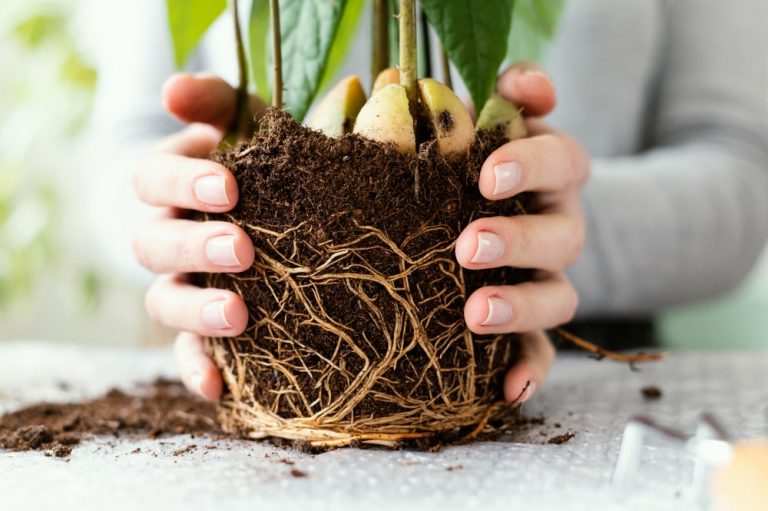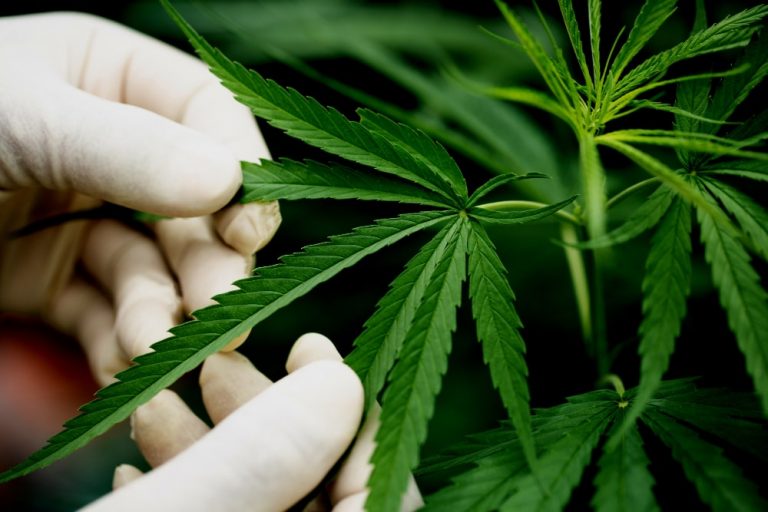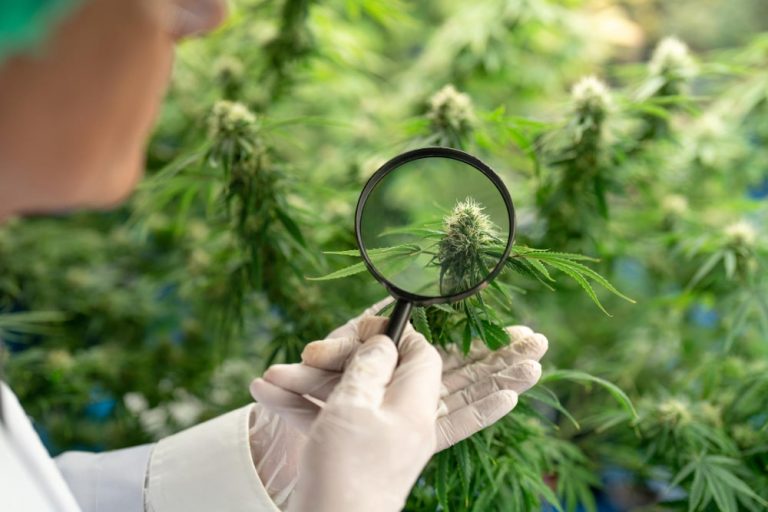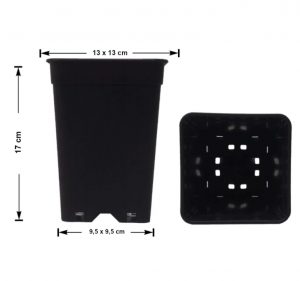If you grow cannabis, you should regularly check your plants for signs of cannabis diseases. This way, you can prevent your plant from being damaged and having to forgo your harvest. In this article, we explain which cannabis diseases are common, how you can recognize them and what you should do if your plant is affected. We will also discuss pest infestations, as these can also cause considerable damage to your cannabis plant.
An easy way to protect your plant from diseases is to use Bonsanto Premium Soil. Our grow soil is composed in such a way that no diseases can develop, as the ingredients of the soil counteract the development of diseases.
Inhaltsverzeichnis
What are the most common hemp diseases?
Depending on how and where you grow, hemp diseases can vary. The most common diseases are hemp mold, root problems, leaf septoria and TMV.
Hemp mold
Hemp mold is the appearance of mold on your plant. Hemp mold should be avoided for various reasons. On the one hand, the quality of the plant suffers due to the mold infestation, so that the taste and aroma of the plant deteriorates. Secondly, the cannabis plant grows more slowly, which leads to lower yields. As everyone knows, mold is also hazardous to health, as harmful substances are produced by the mold that are unhealthy for us humans. The best-known molds are mildew and blossom end rot.
Powdery mildew or peronospora manifests itself as a white, fine powder on the plant leaves and often occurs in damp environments and when the humidity is too high. This type of mold spreads through spores, which can be transmitted in a variety of ways.
Blossom end rot, or gray mold, affects the flowers of your plant. This hemp mold usually occurs during the flowering phase. The buds are attacked by mold, rot and die.
How to recognize hemp mould?
- Gray, black, brown mould stains on leaves, stems or even buds
- Musty smell at the discolored spots
- The discolored spots are moist
- Deformed leaf growth
- Powdery mildew: Mealy white coating on the leaves
- Blossom end rot: Brown, soft, rotten buds
What to do with hemp mold?
- Remove moldy parts of the plant if the mold infestation is not yet very advanced
- Use fungicides suitable for the cannabis plant if the infestation is extensive
How to avoid hemp mold?
- Good drainage
- Bonsanto Premium Soil
- Adequate watering (you can find out more about watering in the blog post “Watering cannabis”)
- Good aeration
- Avoid overfertilization (You can find out more about fertilization in the blog post “Fertilizing hemp for a high-yielding harvest”)
- Regularly check for signs of mold
Cannabis root problems
Root problems are also among the hemp diseases, because healthy cannabis plants have strong roots. If problems occur at the roots, the health of your cannabis plant is at risk.
Root problems can be caused by soil, pot size, watering or temperature. If the temperature is too high, you run the risk of your plant’s roots not being able to absorb enough oxygen. Cold, on the other hand, can shock the roots. Too much watering and a lack of drainage can lead to the roots drowning. If you do not use good grow soil, this can also have negative consequences for the roots of your plant, as they cannot get enough oxygen from the soil.
One of the root problems of cannabis plants is root rot. Too little oxygen and too much watering can be the cause of this. Unfortunately, this problem is difficult to detect as the roots are not directly visible in the pot. Root rot can manifest itself in unhealthy and limp-looking plants.
How to recognize root problems?
- Yellow discolored leaves
- Wilting and falling leaves
- Brown spots on the plant leaves
- Musty smelling and brown roots
- High humidity and mold growth in the root area
What to do with root problems?
- Improve drainage
- Better aeration
- Repot the plant in a new pot with fresh soil
- Cutting off broken roots
How to avoid root problems?
- Good drainage
- Bonsanto Premium Soil
- Controlled and adequate irrigation

Leaf septoria
Leaf septoria is a fungal disease that causes yellow or brown spots on the leaves of your cannabis plant that spread over time. As leaf septoria is resistant to many fungicides, treatment can be difficult.
How to recognize leaf septoria?
- Yellow and brown spots on the leaves
- Spots with black dots
- Falling leaves
- Spreading from bottom to top
What to do with leaf septoria?
- Remove leaves infected by the fungus with sterile scissors
- Avoid contact of infected leaves with other parts of the plant
- Use fungicides that can combat leaf septoria
Ensure good ventilation
How to avoid leaf septoria?
- Good air circulation and ventilation
- Cultivation with clean equipment and accessories
- Avoidance of overwatering
- Proper plant care to avoid stress


Tobacco mosaic virus (TMV)
The TMV virus is also one of the most common hemp diseases. TMV is persistent and can also persist in heat. The virus is transmitted through infected plants, contaminated objects or aphids. Especially in the summer and fall months, the TMV virus spreads quickly. Once your plant is infected with TMV, growth suffers and your plant is weakened. Although the virus does not pose a health risk to humans, an infestation is nevertheless annoying as the harvest will be poor.
How to recognize TMV?
- Slow plant growth
- Deformed leaves
- Ring-shaped yellow-green spots
- Mosaic-like yellow spots
What to do with TMV?
- Separate healthy plants from infected plants
- Clean your plant accessories regularly to prevent the virus from spreading to other plants
How to avoid TMV?
- Clean and hygienic cultivation
- Testing for pests such as aphids that transmit the virus
- Growing cannabis varieties resistant to TMV

Cannabis pests
Pests can also attack your cannabis plant, harm it and cause diseases. To prevent pests from causing problems, you should regularly check your plants for them so that you can intervene at an early stage.
There are a number of pests that can occur when growing cannabis. You can find out what these are here. Most pests can be treated with insecticides, soap sprays or the addition of natural enemies.
Cannabis scale insects & aphids
Scale insects are white, yellow or red insects that infest the branches and stems of your plants. They feed on the sap of your plant, which can lead to problems. They are difficult to recognize as they produce a shield of wax with which they cover themselves. Therefore, you can hardly notice a scale insect infestation on the plant. Aphids infest your cannabis plant on the underside of the leaves and also suck sap out of your plant. They can come in different colors and sizes.
There are a few clues you can use to recognize whether your plant is infested with scale insects or aphids. You may be able to spot them with the naked eye. If this is not the case, yellow leaves and slower growth can also indicate the presence of scale insects. Deformed leaves are an indication of aphids. As the aphids produce honeydew, you can also recognize an infestation by this sticky substance.
To combat infestations of scale insects and aphids, you can use insecticides or a soap spray. Natural enemies of aphids include ladybugs and wasps, for example.

Cannabis mealybugs
White mealybugs are pests that cause considerable damage to your plant health. As they produce a woolly and waxy substance and cover themselves with it, the aphids look fluffy. You can recognize them by the same signs as scale insects and aphids and can control them using the same methods.
Hemp broad mites
Broad mites are very small and therefore barely visible with a magnifying glass or the naked eye.
If your hemp plant is infested with broad mites, it can only grow slowly. The leaves take on a limp and shiny appearance and look unhealthy. As these mites can also infest the flowers of your cannabis plant, this can lead to the flowers falling off. If you notice a broad mite infestation, you should act quickly and use a soap spray or insecticide.
Hemp rust mites
Like broad mites, rust mites are very difficult to detect. It is therefore not easy to detect an infestation. Drooping leaves and yellow discoloration can be a sign of an infestation. Slow growth and a change in bud formation can also indicate an infestation.
Cannabis spider mites
Spider mites can also infest your cannabis plant. In most cases, they are brown or red. They nest on the underside of the leaves of your plant and leave white bite marks. You can therefore detect an infestation by small, white spots on the leaves. Fine cobwebs left behind by the spider mites can also be an indication of an infestation. As spider mites prefer high temperatures and low humidity, you should reduce the temperature and increase the humidity in the event of an infestation. Soap sprays can also combat an infestation.
Whiteflies
Whiteflies usually nest on the underside of leaves. They produce a sticky substance, which attracts mold and can therefore harm your plant. If you move the leaves of your plant, they will fly up. To prevent them from settling on your plant again, you can use a soap spray or certain oils.
Cannabis snails
If your cannabis plant is infested with snails, you have the advantage that this can be noticed quickly and easily. They eat the leaves of your plant and should therefore be removed so as not to harm your plant. You can simply remove the snails by hand and should therefore avoid using a spray.



